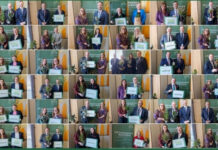
Seven global organizations, including the Sustainable Agriculture Initiative – SAI Platform, are launching today the world’s first practitioner’s guide to sustainable sourcing of agricultural raw materials. The guide is an open source innovation tool that captures, in a single document, real-life best practice and experiences from global corporations within a strategic, business logic-focused framework.

Seven global organizations, including the Sustainable Agriculture Initiative – SAI Platform, are launching today the world’s first practitioner’s guide to sustainable sourcing of agricultural raw materials. The guide is an open source innovation tool that captures, in a single document, real-life best practice and experiences from global corporations within a strategic, business logic-focused framework. It empowers managers by providing a user-friendly step-by step roadmap to building and rolling out sustainable agriculture sourcing strategies effectively.
Climate change, increasing pressure on natural resources and continuing poverty and social inequity are affecting crops and water supply globally. As the food & beverage industry is the world’s biggest purchaser of agricultural raw materials, this is a significant industry risk. For a secure, safe and increasing supply, crops must be grown and sourced in a sustainable manner taking full account of environmental, social and economic considerations. Doing this effectively calls for changes in managerial mind-sets and specific knowledge and skillsets.
To help companies convert these risks to business opportunities, a unique collaboration between seven high profile organizations has led to the production of the guide. The guide pools knowledge and resources, but collaborative outreach will also be an important part of assuring its impact. The collaborating partners are: the Sustainable Agriculture Initiative (SAI) Platform, the CSL Learning Platform of IMD’s Global Center for Sustainability Leadership, the International Trade Centre, and the Sustainable Trade Initiative. Furthermore, BSR, the Sedex Information Exchange and the Sustainable Food Laboratory also contributed to the development of the guide and are supporting its outreach.
Dr. Ernesto A. Brovelli, President of the SAI Platform and Senior Manager, Sustainable Agriculture with The Coca-Cola Company comments : ” This work reflects the spirit of the SAI Platform; one which aligns farmers and the food and beverage industry behind a common pursuit. Following a compelling narrative and clear examples, this publication is breaking ground in helping the reader navigate the path towards more sustainable sourcing.”
Executive Summary
This Guide is the result of a cooperative effort by the Sustainable Agriculture Initiative (SAI) Platform, the CSL Learning Platform of IMD’s Global Center for Sustainability Leadership (CSL), the International Trade Center, and the Sustainable Trade Initiative. Furthermore, Business for Social Responsibility, the Sedex Information Exchange and the Sustainable Food Laboratory also contributed to the development of the guide and are supporting its outreach. It is intended to help practitioners in companies that are seeking to source their agricultural raw materials sustainably, by asking and answering crucial questions in the following eight chapters:
1. How to Use this Guide
In this chapter, we emphasise that there is no need to read this guide from cover to cover. The order of the different chapters is not necessarily the order in which you need to address issues in your firm. You may choose your own entry points, according to your needs.
2. Sustainable Sourcing as Leadership and Value Creation
Chapter 2 gives a general background on the strategic importance and the strategic conditions to successfully implement sustainable sourcing in a firm. It links our specific topic (‘sustainable sourcing’) to general strategic issues, the business context, the importance of stakeholder pressure and value drivers.
3. Implementing Sustainable Sourcing – Decisions to be Made
This chapter gives a short overview of the different aspects that are the basis for chapters 4 to 8 in the guide, which deal with the process of implementing a sustainable sourcing strategy. In reality, decisions may develop in a different order than the one proposed, or parallel to each other.
4. Setting Priorities for your Company’s inputs from Agriculture
Chapter 4 proposes a number of questions to ask before developing sustainable sourcing in great detail. The first step is to set priorities (priority raw materials, priority countries, priority issues, etc.) and to base a consistent sustainable sourcing programme on them.
5. Choosing Appropriate Sustainability Requirements
The next step, described in Chapter 5, is to define the level of sustainability you want to achieve for specific agricultural raw materials: what sustainability criteria and minimum requirements. What role internally or externally defined standards may or may not play is also discussed in this chapter.
6. Implementing Sustainability Standards in your Company’s Supply Chain
Chapter 6 focuses on how to implement your sustainable sourcing ambitions. Of course, the steps needed for implementation are strongly dependent on the character of the supply chains. Direct sourcing is different from sourcing through suppliers or from commodity markets. There may be a need to redesign supply chains for the sake of sustainability. In the case of direct sourcing, implementation may require your company to be active in supporting farmers, possibly in cooperation with other companies sourcing from the same area. This chapter also addresses questions around monitoring implementation and certification. It does not give a binding advice on whether to seek certification or not, but provides a number of questions that you may want to ask before making a decision. The chapter concludes by looking at the relevance of impact assessment.
7. Adapting your Company’s Business Culture, Processes and Structures
In order to achieve sustainable sourcing, changes will be required in your firm’s business processes both internally and externally. Actual or new managers will notably be required to acquire a vast rage of new skills, including the management of new relationships with suppliers and farmers, It will be probably also be necessary to change the reward systems for managers and the allocation of resources for rolling out a sustainable sourcing strategy.
8. Communicating the Company’s Sustainable Sourcing Efforts
The guide concludes with a short chapter on how to communicate the company’s sourcing efforts to the outer world.
Throughout the guide, real-life examples are given from a variety of companies in the food and beverage sector. These are meant to inspire managers in other companies. They are not meant to simply be replicated as, throughout the document, we stress that solutions found in one company will not necessarily work in another. This is the reason why this guide is built around questions rather than final answers.






